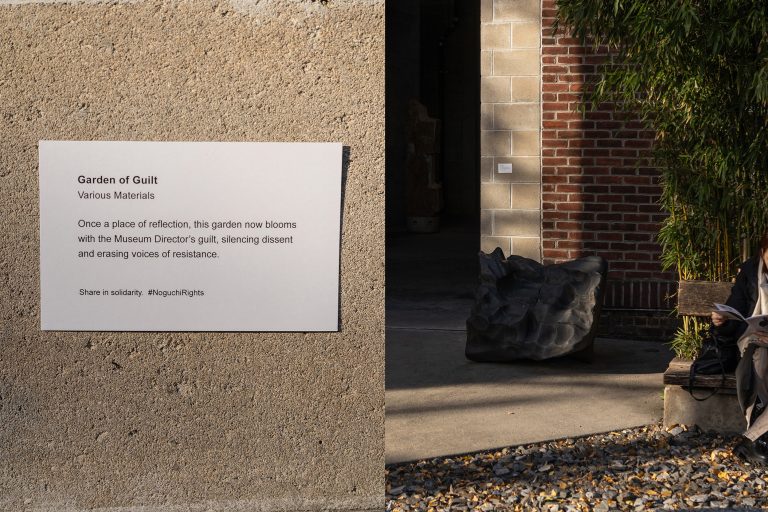Over the weekend, a group of anonymous activists staged a guerrilla action at New York’s Noguchi Museum to protest the institution’s recent ban on hijabs and the firing of related employees, posting mock text on the walls mocking the controversial policy.
In a press release shared with allergic The group said it intended to use the museum’s space to directly criticize the Arab and Palestinian headscarf ban imposed last September, which the museum said was an “update” to its dress code.
Rather than rewriting wall text for the exhibited work by Japanese-American artist Isamu Noguchi, the group developed new text for ordinary objects around the museum, such as a piece of paper called the “Exile Bench.” A bench, a chair called a “seat”. The Sound of Silence,” a fire alarm called “Annihilation Alarm,” and more.
“This wall is a border used by museums to erase cultures, ban hijabs, and fire staff who challenge their racist views,” reads a label posted on the wall.

The group also printed a variety of mock ID cards with fake titles for museum administrators and board members, labeling director Amy Hau as the “Museum Neutral Director” and board co-chairman Spencer Marked Spencer Bailey as a member of the “Committee of Distrust” tasked with “suppressing dissent.”
They also created and hid several bookmarks featuring turbans between the pages of various books throughout the museum, according to the release. Each bookmark includes the signature black-and-white fishnet and olive leaf design on a standard turban pattern, along with a caption stating that the museum prohibits staff from wearing this attire or any other “political attire” that might make visitors feel “unsafe.” or “uncomfortable”.
“You hid the hijab – now it’s your turn to find it, supervisor,” the group said in a news release.
A spokesman for the Noguchi Museum did not respond. allergicinquiry.


Flatbush resident Jessica, 40, who asked only to be identified by her first name, told reporters allergic She visited the museum on the afternoon of Saturday, December 7, and saw some of the writing on the walls.
“My team and I were killing some time in the garden before the tour started at 2pm and I just noticed this little tag on a bench that reminded me of the hijab controversy at the museum,” Jessica said .
“So from that point on I started keeping an eye out for them and then a second one showed up in the garden,” she continued. “We were in the front hall and I saw a security guard also notice the tags and pick up the three tags outside. I saw other people see them and come closer too and then I overheard this guy Talk to staff about this.”
jessica told allergic She found the wall text app to be a smart way to resolve disputes, even noting that the tags “added to the exhibition tour.”
Jessica said: “Given Noguchi’s history as a multiracial child born to a single mother who was voluntarily interned during a period of anti-Japanese sentiment, he may now be rolling in his grave over the museum’s decision. ”


The action is one of a series of recent interventions in response to the museum’s stance on employees wearing headscarves on site. In late October, protesters gathered quietly outside the museum during its annual gala and awards ceremony for Korean artist Lee Ufan. Bangladeshi British-American writer Jhumpa Lahiri refused to accept the award ahead of the ceremony in response to the hijab ban. Earlier that month, California artists David Horvitz and Ali Eyal placed hoods on Noguchi sculptures in Los Angeles and Orange County in response to the museum’s policy.
The protests came days after Pope Francis unveiled a nativity scene in the Vatican in Rome, in which the baby Jesus lies in a hood in a manger. The Nativity was designed by Johny Andonia and Faten Nastas Mitwasi, two Palestinian artists from Bethlehem in the West Bank, as a joint project orchestrated by Dal Kalima University, the Palestinian Embassy to the Holy See and the Palestinian High Presidential Council. Church Affairs in Palestine.




